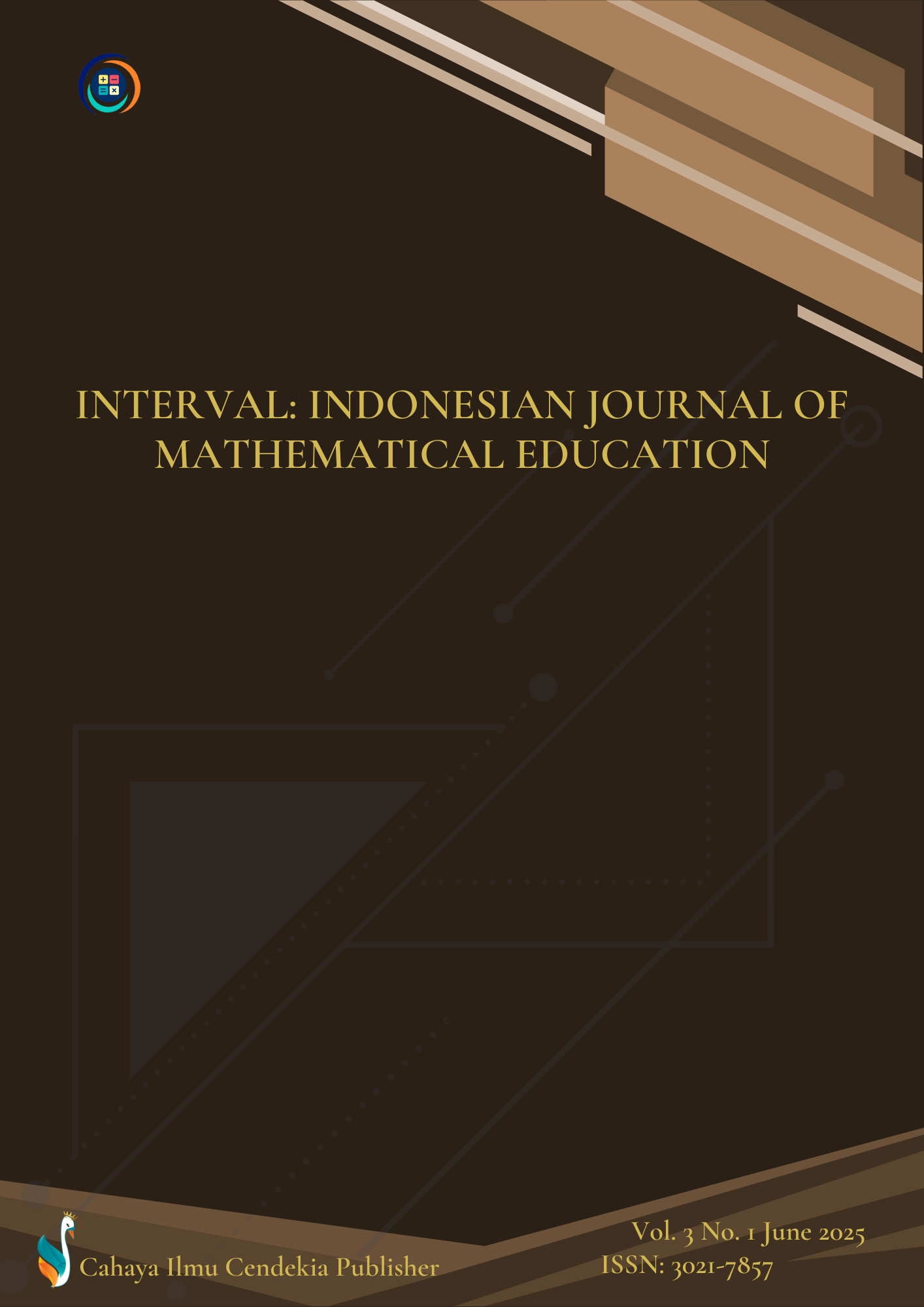Cultural Values and Their Role in Shaping the Adaptation of Realistic Mathematics Education (RME) in Indonesia: A Mixed-Methods Approach
Abstract
Purpose of the study: The main objective of the study is to analyze how cultural factors influence the implementation of RME in the context of mathematics education in Indonesia.
Methodology: The method used is a qualitative study employing content/document analysis of curriculum guidelines and instructional materials. Additionally, semi-structured interviews were conducted with six educators, and non-participant observations were carried out in three schools to examine the implementation of Realistic Mathematics Education (RME).
Main Findings: The results of the study showed that the success of RME adaptation was influenced by local cultural values, such as community-based approaches and the context of students' daily lives.
Novelty/Originality of this study: The novelty of this research lies in the in-depth analysis of the interaction between RME principles and Indonesian cultural characteristics, providing new insights into the development of more contextual and effective mathematics learning strategies.
References
A. M. Alzoebi, M. A. Ghunaimat, and E. A. Alawneh, “The Effects of Flipped Classroom Strategy Based on ‘Addie Model’ for Algebraic Skill Development,” Anatol. J. Educ., vol. 8, no. 1, pp. 141–158, 2023, doi: 10.29333/aje.2023.8110a.
D. Setiawan, “The development of authentic assessment instrument to expand the character values of citizenship education at primary school No 104202 and No 106811 Bandar Setia, Medan, Indonesia,” Budapest Int. Res. Critics Linguist. Educ. J., vol. 2, no. 1, pp. 79–90, Feb. 2019, doi: 10.33258/birle.v2i1.188.
A. Zappone, M. Di Renzo, and M. Debbah, “Wireless Networks Design in the Era of Deep Learning: Model-Based, AI-Based, or Both?,” IEEE Trans. Commun., vol. 67, no. 10, pp. 7331–7376, 2019, doi: 10.1109/TCOMM.2019.2924010.
D. Lombardi et al., “The Curious Construct of Active Learning,” Psychol. Sci. Public Interes., vol. 22, no. 1, pp. 8–43, 2021, doi: 10.1177/1529100620973974.
B. H. See, S. Gorard, B. Lu, L. Dong, and N. Siddiqui, “Is technology always helpful?: A critical review of the impact on learning outcomes of education technology in supporting formative assessment in schools,” Res. Pap. Educ., vol. 37, no. 6, pp. 1064–1096, 2022, doi: 10.1080/02671522.2021.1907778.
P. Nabela, S. Alarsan, and P. T. K. Hue, “A Study of Knowledge and Attitudes of Health Students towards Acute Respiratory Infections (ARI) in Lubuklinggau City,” J. Eval. Educ., vol. 5, no. 2, pp. 68–73, 2024, doi: 10.37251/jee.v5i2.935.
Tolley, Qualitative Methods in Public health : a Field Guide For Applied Research. Fransisco: Willey, 2017.
F. Saltan and Ö. Arslan, “The use of augmented reality in formal education: A scoping review,” Eurasia J. Math. Sci. Technol. Educ., vol. 13, no. 2, pp. 503–520, 2017, doi: 10.12973/eurasia.2017.00628a.
M. W. Habibi, L. Jiyane, and Z. Özşen, “Learning Revolution: The Positive Impact of Computer Simulations on Science Achievement in Madrasah Ibtidaiyah,” J. Educ. Technol. Learn. Creat., vol. 2, no. 1, pp. 13–19, 2024, doi: 10.37251/jetlc.v2i1.976.
M. Y. Al-Hamad and I. S. Qamber, “TVA generating unit modeling using MATLAB,” J. Assoc. Arab Univ. Basic Appl. Sci., vol. 17, pp. 73–81, 2015, doi: 10.1016/j.jaubas.2014.05.003.
R. Kapçiu, B. Preni, E. Kalluçi, and R. Kosova, “Modeling Inflation Dynamics Using the Logistic Model: Insights and Findings,” J. Ilm. Ilmu Terap. Univ. Jambi, vol. 8, no. 1, pp. 364–378, 2024, doi: 10.22437/jiituj.v8i1.32605.
R. Aradea, S. Cahyono, R. N. Sasongko, M. Kristiawan, and N. D. Lestari, “The Impact of a Scramble-Based Cooperative Learning Model Using Video Media on Student Learning Outcomes,” AL-ISHLAH J. Pendidik., vol. 14, no. 4, pp. 6551–6558, 2022, doi: 10.35445/alishlah.v14i4.2315.
S. Glotov and S. Glotov, “Finnish visual art teachers ’ perspectives,” vol. 15, no. 1, pp. 31–43, 2023.
S. L. Craig, T. Gardiner, A. D. Eaton, N. Pang, and T. Kourgiantakis, “Practicing alliance: an experiential model of teaching diversity and inclusion for social work practice and education,” Soc. Work Educ., vol. 00, no. 00, pp. 1–19, 2021, doi: 10.1080/02615479.2021.1892054.
P. Cantor, D. Osher, J. Berg, L. Steyer, and T. Rose, “Malleability, plasticity, and individuality: How children learn and develop in context1,” Appl. Dev. Sci., vol. 23, no. 4, pp. 307–337, 2019, doi: 10.1080/10888691.2017.1398649.
D. McGillivray and J. Mahon, “Distributed digital capital: digital literacies and everyday media practices,” Media Pract. Educ., vol. 22, no. 3, pp. 196–210, 2021, doi: 10.1080/25741136.2021.1899628.
R. Bellová, D. Melicherčíková, and P. Tomčík, “Possible reasons for low scientific literacy of Slovak students in some natural science subjects,” Res. Sci. Technol. Educ., pp. 1–18, 2017, doi: 10.1080/02635143.2017.1367656.
N. Tytova, “Digital literacy of future teachers in the realities of large-scale military aggression (Ukrainian experience),” Futur. Educ., vol. 2, pp. 43–54, 2022, doi: 10.57125/fed/2022.10.11.33.
H. Kurniawan, R. Y. Purwoko, and D. S. Setiana, “Integrating cultural artifacts and tradition from remote regions in developing mathematics lesson plans to enhance mathematical literacy,” J. Pedagog. Res., vol. 8, no. 1, pp. 61–74, 2024, doi: 10.33902/JPR.202423016.
R. I. Rauf, O. J. Ifeyinwa, and H. U. Yahaya, “Robustness Test of Selected Estimators of Linear Regression with Autocorrelated Error Term: A Monte-Carlo Simulation Study,” Asian J. Probab. Stat., vol. 15, no. 2, pp. 1–17, 2021, doi: 10.9734/ajpas/2021/v15i230348.
P. J. Miller and R. Cameron, “Mixed method research designs: A case study of their adoption in a doctor of business administration program,” Int. J. Mult. Res. Approaches, vol. 5, no. 3, 2011, doi: https://doi.org/10.5172/mra.2011.5.3.387.
C. Perrotta, C. Bailey, and C. Garside, “Culture , technology and local networks : towards a sociology of ‘ making ’ in education,” Cambridge J. Educ., vol. 3577, no. September, pp. 1–17, 2017, doi: 10.1080/0305764X.2017.1375459.
K. Vakili and Z. Pourrazavy, “CORRESPONDENCE Khatoon Vakili,” vol. 12, no. 4, pp. 755–761, 2017.
S. Zinn, U. Landrock, and T. Gnambs, “Web-based and mixed-mode cognitive large-scale assessments in higher education: An evaluation of selection bias, measurement bias, and prediction bias,” Behav. Res. Methods, vol. 53, no. 3, pp. 1202–1217, Jun. 2021, doi: 10.3758/s13428-020-01480-7.
F. Mulisa, “Sampling techniques involving human subjects: Applications, pitfalls, and suggestions for further studies,” Int. J. Acad. Res. Educ., vol. 8, no. 1, pp. 75–84, 2022, doi: 10.17985/ijare.1225214.
M. A. Valerio et al., “Comparing two sampling methods to engage hard-to-reach communities in research priority setting,” BMC Med. Res. Methodol., vol. 16, no. 1, pp. 1–11, 2016, doi: 10.1186/s12874-016-0242-z.
R. Ambarwati, E. B. Ulla, and M. Tajaddini, “Analysis of High School Students’ Learning Discipline in Physics Learning,” Schrödinger J. Phys. Educ., vol. 4, no. 4, pp. 112–117, 2023, doi: 10.37251/sjpe.v4i4.764.
M. Bashori, “I love Indonesia: Perceptions of Web-facilitated language learning among learners of English as a Foreign Language,” JALT CALL J., vol. 14, no. 2, pp. 157–189, 2018.
L. A. Maharani and S. B. Waluya, “Systematic Literature Review: Implementation of a Problem-Based Learning Model with Ethnomathematics Nuances in Improving Students’ Mathematical Problem Solving Ability,” J. Pendidik. Mat., vol. 1, no. 2, p. 13, 2023, doi: 10.47134/ppm.v1i2.218.
C. P. Vistro-Yu, “Ethnomathematics for Capacity Building in Mathematics Education,” pp. 2–15, 2010, [Online]. Available: https://www.researchgate.net/publication/364934080
A. Gutiérrez-Martín, R. Pinedo-González, and C. Gil-Puente, “ICT and Media competencies of teachers. Convergence towards an integrated MIL-ICT model,” Comunicar, vol. 30, no. 70, pp. 19–30, 2022, doi: 10.3916/C70-2022-02.
M. Leonida, “Learning from film to theatre and from theatre to film,” Film Educ. J., vol. 4, no. 2, 2021, doi: 10.14324/fej.04.2.05.
J. Jufrida, W. Kurniawan, A. Astalini, D. Darmaji, D. A. Kurniawan, and W. A. Maya, “Students’ attitude and motivation in mathematical physics,” Int. J. Eval. Res. Educ., vol. 8, no. 3, pp. 401–408, 2019, doi: 10.11591/ijere.v8i3.20253.
F. B. Agusto, M. I. Teboh-Ewungkem, and A. B. Gumel, “Mathematical assessment of the effect of traditional beliefs and customs on the transmission dynamics of the 2014 Ebola outbreaks,” BMC Med., vol. 13, no. 1, pp. 1–17, 2015, doi: 10.1186/s12916-015-0318-3.
L. C. Dessi and M. Shah, “Application of the Numbered Head Together Type Cooperative Learning Model to Improve Student Learning Outcomes in Mathematics Subjects,” Interval Indones. J. Math. Educ., vol. 1, no. 2, pp. 67–72, 2023, doi: 10.37251/ijome.v1i2.773.
G. Cera, A. Mlouk, E. Cera, and A. Shumeli, “The impact of entrepreneurship education on entrepreneurial intention. A quasi-experimental research design,” J. Compet., vol. 12, no. 1, pp. 39–56, 2020, doi: 10.7441/joc.2020.01.03.
Copyright (c) 2025 Sagir Adamu Abbas, Annabelle M. Quiño, Nayantara Abraham

This work is licensed under a Creative Commons Attribution 4.0 International License.
Authors who publish with this journal agree to the following terms:
- Authors retain copyright and acknowledge that the Interval: Indonesian Journal of Mathematical Education is the first publisher licensed under a Creative Commons Attribution 4.0 International License.
- Authors are able to enter into separate, additional contractual arrangements for the non-exclusive distribution of the journal's published version of the work (e.g., post it to an institutional repository or publish it in a book), with an acknowledgment of its initial publication in this journal.
- Authors are permitted and encouraged to post their work online (e.g., in institutional repositories or on their website) prior to and during the submission process, as it can lead to productive exchanges and earlier and greater citation of published work.





.png)
.png)













